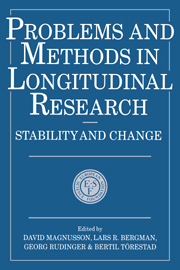Book contents
- Frontmatter
- Contents
- Contributors to this volume
- Foreword
- Preface
- 1 Studying individual development: problems and methods
- 2 Modeling individual and average human growth data from childhood to adulthood
- 3 Intraindividual variability in older adults' depression scores: some implications for developmental theory and longitudinal research
- 4 Now you see it, now you don't – some considerations on multiple regression
- 5 Differential development of health in a life-span perspective
- 6 Assessing change in a cohort-longitudinal study with hierarchical data
- 7 Statistical and conceptual models of ‘turning points’ in developmental processes
- 8 Qualitative analyses of individual differences in intra- individual change: examples from cognitive development
- 9 Application of correspondence analysis to a longitudinal study of cognitive development
- 10 Event-history models in social mobility research
- 11 Behavioral genetic concepts in longitudinal analyses
- 12 Genetic and environmental factors in a developmental perspective
- 13 Structural equation models for studying intellectual development
- 14 Longitudinal studies for discrete data based on latent structure models
- 15 Stability and change in patterns of extrinsic adjustment problems
- Index
15 - Stability and change in patterns of extrinsic adjustment problems
Published online by Cambridge University Press: 27 April 2010
- Frontmatter
- Contents
- Contributors to this volume
- Foreword
- Preface
- 1 Studying individual development: problems and methods
- 2 Modeling individual and average human growth data from childhood to adulthood
- 3 Intraindividual variability in older adults' depression scores: some implications for developmental theory and longitudinal research
- 4 Now you see it, now you don't – some considerations on multiple regression
- 5 Differential development of health in a life-span perspective
- 6 Assessing change in a cohort-longitudinal study with hierarchical data
- 7 Statistical and conceptual models of ‘turning points’ in developmental processes
- 8 Qualitative analyses of individual differences in intra- individual change: examples from cognitive development
- 9 Application of correspondence analysis to a longitudinal study of cognitive development
- 10 Event-history models in social mobility research
- 11 Behavioral genetic concepts in longitudinal analyses
- 12 Genetic and environmental factors in a developmental perspective
- 13 Structural equation models for studying intellectual development
- 14 Longitudinal studies for discrete data based on latent structure models
- 15 Stability and change in patterns of extrinsic adjustment problems
- Index
Summary
INTRODUCTION
Research on individual development has been strongly dominated by an interest in variables; in the characteristics of and interrelationships among person variables, and in the relationships between person variables and environmental variables (Thomae, 1988; Wohlwill, 1973). However, if the focus is on an analysis of the character of the structures and processes involved in the total functioning of an individual – in a current and in a developmental perspective – it is easy to see that this approach to the study of individual development has clear limitations (Magnusson, 1985, 1988).
Individual functioning can be described as a multidetermined stochastic process partly unique to the individual; a characteristic that is reflected in strong interactions and nonlinearity in data across individuals. This view leads to the conclusion that we have to complement the variable-oriented approach with one in which the person as a gestalt is the central object of interest. Operationally, such a person orientation implies that individuals are studied on the basis of their patterns of individual characteristics relevant for the study of the problem under consideration.
Several methodological approaches are possible for the study of individual development in terms of patterns. The aim of the present chapter is to illustrate the applicability of a cluster analysis oriented methodology to research on individual development, by presenting an empirical study concerned with the issue of early maladjustment behaviors as precursors of later adjustment problems.
- Type
- Chapter
- Information
- Problems and Methods in Longitudinal ResearchStability and Change, pp. 323 - 346Publisher: Cambridge University PressPrint publication year: 1991
- 32
- Cited by



